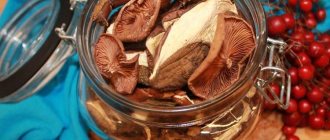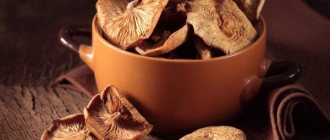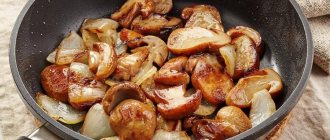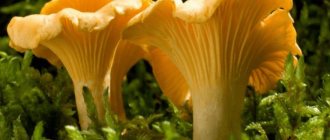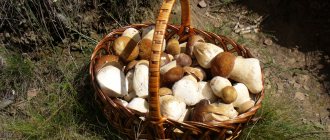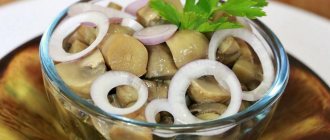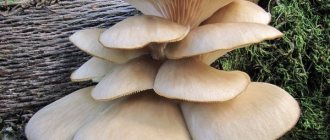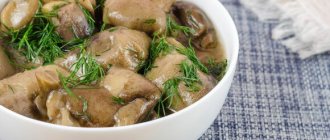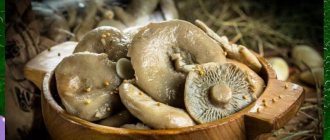Porcini mushrooms, or porcini mushrooms, are very attractive in appearance. They have a thick, fleshy leg and a large cap, and the taste of the pulp is extremely pleasant, not only when fried or salted, but also dried. Drying is considered the easiest way to preserve the harvest throughout the winter, especially since this process does not require significant labor, and dried mushrooms can be an excellent addition to any dishes.
If you plan to dry boletus mushrooms for the winter, you should familiarize yourself with the details of this process and drying methods in advance, because the quality of the preparation will depend on this. You will find useful tips on how to dry porcini mushrooms at home correctly in our article today.
How to dry porcini mushrooms at home
All fresh fruit bodies contain a lot of water in the pulp, so they are not intended for long-term storage raw. Within a few days they wither, lose density and taste. Therefore, immediately after collection, care must be taken to preserve boletus mushrooms throughout the winter.
Note: There are many methods for harvesting, and boletus mushrooms are considered universal, since they do not lose their taste after salting, pickling, freezing or drying. The last method is considered the simplest, since you do not have to spend a lot of time and effort on the preparation.
The main purpose of drying is to remove most of the moisture from their pulp naturally. This way you will get a high-quality product that can be stored in a dry glass jar with a lid for several months, and in some cases, years. During the process of drying and removing moisture, microorganisms die in the pulp, which simply cannot live and reproduce in such a dry environment.
Despite the fact that drying boletus mushrooms is considered the easiest way to prepare them, you need to properly prepare for this process. Only if certain conditions are met will the preparation turn out to be truly tasty, healthy and aromatic.
How to prepare mushrooms for drying
A key role in the quality drying of boletus mushrooms is played by their proper preparation. It is advisable to send them for processing as quickly as possible, since during storage the pulp loses density, taste and aroma (Figure 1).
Figure 1. Preparation of fruiting bodies
Since all mushrooms, especially tubular ones, which include boletus, quickly absorb moisture, they cannot be washed before drying. It is enough to simply remove the remaining soil, leaves and other debris from their surface. Heavily soiled specimens can be lightly wiped with a dry cloth or scraped with the back of a knife. It is also advisable to cut off the lower part of the stem, on which particles of earth may remain. This is where the preparation ends. All that remains is to choose the appropriate method for drying boletus mushrooms at home.
Preparation of raw materials
Tubular species with a dense pulp structure are best suited for drying: white and boletus mushrooms, boletus and red-headed boletus, boletus.
Damaged and old copies are strictly prohibited from being used. The mushrooms are carefully examined for damage: wormholes, rot, mold. Use a brush or sponge to clean off any accumulated debris. Selected mushrooms are not washed; it is only permissible to wipe them with a damp cloth or rinse lightly in case of heavy contamination.
Experienced mushroom pickers clean and sort forest crops at the harvesting stage
For convenience, the raw materials are prudently cut into pieces, the caps and stems are dried separately.
Large caps are cut into thin slices, small ones are cut in half, the stems are divided into arbitrary, but not too small pieces.
How to properly cut mushrooms for drying
Usually boletus mushrooms are dried whole, laying them out with their caps down or hanging on a thread. But in some cases, in order to save time, especially large specimens are cut into pieces (Figure 2).
Figure 2. Slicing methods
Slicing boletus mushrooms for drying is practiced only if they are treated with warm air from a stove or oven. It is technologically correct to cut large specimens lengthwise, dividing both the stem and the cap in half. In the future, such prepared boletus mushrooms can be placed on a baking sheet or strung on long metal or wooden knitting needles. In this case, the fruiting bodies dry evenly and do not burn. Small ones may not be cut, as there is a high risk of over-drying them in a hot oven. But cutting large specimens will help make them more uniform, simplify the drying process and make it of better quality.
Drying temperature and time
The temperature regime is determined in accordance with the chosen drying method, the amount of raw materials, the degree of preparation, and the time that should be spent on the process is also taken into account.
Whatever method is chosen, all the workpieces are laid out in a thin layer, separately from each other, since if they are placed one on top of the other, then all the raw materials will dry unevenly and the desired result will not be achieved.
It is necessary to regulate the temperature and keep it at a level of fifty-five to seventy degrees. The average processing time is approximately six to eight hours.
How to properly dry porcini mushrooms at home
Not everyone has the opportunity to dry porcini mushrooms in a real oven, although this method is considered the best, since the finished products retain their color, taste and aroma. But city residents should not be upset: they can be dried efficiently in other ways, and the finished boletus mushrooms will turn out almost as good as those treated with warm air in the oven.
In general, drying methods are divided into two types. The first involves preparing boletus in the fresh air: for example, in the sun or on a thread suspended in the attic. The second type involves the use of various equipment and other benefits of civilization: ovens, microwaves or special electric dryers. To make it easier for you to choose the appropriate method, we will look at each of them in more detail.
Drying mushrooms on a string
Stringing boletus mushrooms on a thread for drying is considered one of the oldest harvesting methods. The thread can be hung near the stove or stove, or in any other place where the boletus mushrooms will be blown with warm air (Figure 3).
Figure 3. Thread drying
First of all, you need to properly prepare the harvest. Mushrooms are cleared of debris and parted with soil, the lower part of the stem is cut off. Small boletus mushrooms are strung whole on a thread, and large specimens are cut into two parts along the stem. Thread or twine is threaded through the central part of the leg so that during the drying process the fungus does not fall off the thread. In the future, such a blank can be hung in a warm, well-ventilated area. You can speed up the drying process if the mushrooms are located near a warm radiator, stove or stove.
How to dry porcini mushrooms in the sun
In general, it is not customary to dry boletus mushrooms in the bright sun, since in this case their pulp will lose moisture too quickly, the workpiece will turn out dry and will begin to crumble during storage.
Note: If you still prefer to dry the mushrooms naturally, you can spread them on a baking sheet or string them on a thread, and then move them to a warm room with good ventilation and moderate lighting. It is important that the fruiting bodies do not come into contact with each other, so the boletus mushrooms are laid out in one layer, caps down.
If you are using a metal baking tray, it is advisable to cover it with straw or dry leaves and only then lay out the fruiting bodies. If you do not do this, the workpiece will develop a pronounced metallic taste.
The sun drying method is extremely popular among those who go to the forest for several days and cannot process the harvested crop in any other way (Figure 4). To do this, you will need wooden knitting needles (ramrods) on which boletus mushrooms are strung. It is advisable to use wooden sticks, since contact with metal may cause the fruiting bodies to darken. Small specimens are strung whole on ramrods, while large specimens can either be cut in half or the cap separated from the stem. Regardless of the size of the fruiting bodies, they must be strung in such a way that they do not touch each other.
Figure 4. Sun drying options
Next, the ramrods are inserted into the stand so that the knitting needles are positioned vertically. For example, for this purpose you can use a box or other container with sand or earth. The prepared cleaning rods are transferred to the windward side and left in the sun for 2-3 days. It is better to cover the top of the mushrooms with a loose cloth or gauze so that flies and other insects do not land on them. It should be borne in mind that when using this method, it will not be possible to completely dry the mushrooms and they will have to be dried in a stove or oven.
In electric and gas oven
The principle of drying in an electric oven is approximately the same as in a wood-burning oven. It is advisable to place the boletus mushrooms not on a wire rack, but on baking sheets covered with parchment paper. Then they will not absorb the unpleasant metallic smell and taste (Figure 5).
In general, drying mushrooms in the oven looks like this:
- Prepared boletus mushrooms are laid out on a baking sheet with their caps down. Large specimens are cut lengthwise or the cap is separated from the stem.
- The baking sheet is placed in the oven and the temperature is turned on to 50-55 degrees. In such conditions, the fruiting bodies should languish for several hours.
- Next, take the boletus mushrooms out of the oven, let them cool a little and put them back in the oven, but turn the temperature up to +70 degrees.
Figure 5. Oven drying process
It is important that there is enough air inside the oven during the process. If there are no ventilation holes inside, the door should be kept slightly open so that warm air evenly blows across all the fruiting bodies.
Such drying allows you to evenly remove moisture from the fruiting bodies, but dry out the mushrooms. Otherwise, as when treated with too hot air, the mushrooms will become too brittle and will crumble during storage.
In the microwave
A small amount of mushrooms can be dried in a regular microwave. To do this, prepared boletus mushrooms are laid out on a plate and placed in the oven. The microwave power should be at the level of 100-200 W. The drying time in this case is only 18 minutes.
Figure 6. Microwave drying
Next, you need to take them out, let them cool completely and repeat the procedure two or three times. The number of approaches depends on the size of the fruiting bodies: small ones lose moisture much faster than large ones (Figure 6). If you still notice that the boletus mushrooms are not completely dry, you can cook them in the sun or in the oven.
In an electric dryer
An excellent example of household appliances is an electric dryer, in which you can dry vegetables, fruits, spicy and medicinal herbs, as well as mushrooms. However, it should be borne in mind that the duration of cooking whole boletus mushrooms in such a device will be very long, so it is better to immediately cut large specimens into small pieces.
Figure 7. Placing fruiting bodies in an electric dryer
To make the preparation, the fruiting bodies are laid out on a drying rack so that they do not touch each other and the temperature is set to +55 degrees. In such conditions, boletus mushrooms should be treated with warm air for 6-9 hours, but the duration directly depends on the power of the equipment and its model (Figure 7).
In general, we can say that an electric dryer is the best modern way of preparing boletus mushrooms for the winter. The chamber of this device creates the most suitable conditions for treating fruiting bodies with warm air, and a constant supply of oxygen leads to uniform evaporation of moisture. As a result, finished dried mushrooms retain their unique taste and aroma.
Preparation
Having learned about the variety of beneficial properties of champignons, it would be nice to now familiarize yourself with several recommendations that will help you tasty and easily cook champignons in the oven:
When choosing mushrooms for baking, it is very important to pay attention to their appearance. It should not cause you any suspicion. The mushroom should be quite elastic and without any stains. For baking in the oven, it is best to choose already mature mushrooms, as they will be more tasty and aromatic. Large specimens are suitable for stuffing recipes
It is only important to choose champignons of approximately the same size. Small ones are more useful for making julienne, casseroles or roasting on a skewer. If you place a small piece of butter in each mushroom cap before stuffing them, then when baking in the oven their skin will not wrinkle. If you need to get rid of the stem of a mushroom, the best assistant is a teaspoon, which will not damage the mushroom itself, unlike a knife. With its help, you can also easily and simply remove the pulp from the cap, and then there will be more space for the filling. There is no need to throw away mushroom stems, even if the recipe calls for them to be removed, as they can be used in another, equally tasty dish or simply frozen. You should cut only before cooking the mushrooms, because otherwise they will immediately darken. Champignons can go well with black pepper, khmeli-suneli spices, nutmeg, paprika, garlic, onion and even cream and sour cream. All these ingredients will be an excellent flavor enhancer for champignons. If it is necessary to reduce the calorie content of stuffed champignons baked in the oven, you should replace products with higher fat content with more dietary ones (for example, mayonnaise with low-fat sour cream or cream).
Wash the mushrooms thoroughly. If they have a grayish or brownish tint, it is better to clean them. Beautiful white mushrooms do not need to be peeled.
Prepared mushrooms need to be seasoned. For this we use salt and prepared spices. If you do not have a mixture of Italian or Provencal herbs, you can collect the mixture yourself. Dried thyme, basil, dill, parsley and celery leaves are suitable for mushrooms.
Add sour cream to the champignons. Its fat content does not matter - use whatever you have. You can also dilute it a little with mayonnaise. Then the taste of the dish will become richer.
Place the mushrooms in a deep baking dish. A special mold or frying pan without a handle will do.
Heat the oven to 180-190 degrees and place the mold with mushrooms into it. Bake for 20-30 minutes. The exact cooking time will depend on the size of the mushrooms. If they are browned on top and have shrunk in size, they are ready.
We suggest you familiarize yourself with the best way to cook pheasant
Place them on a plate or salad bowl and serve. If you wish, you can sprinkle the hot mushrooms with herbs, chopped garlic or grated cheese.
How to store dried porcini mushrooms
It is important not only to properly prepare and dry the mushrooms, but also to preserve them until the new “quiet hunting” season. Despite the fact that pathogenic microorganisms do not multiply in moisture-deprived pulp, under certain conditions they can still deteriorate.
Firstly, they should be stored only in clean and dry glass jars with a tight lid (Figure 8). If desired, plastic containers can be used for the same purpose. However, it is necessary to ensure that such a container does not have a characteristic unpleasant odor. The fact is that dried mushrooms absorb odors well, and the aroma of plastic can spoil the preparation.
Figure 8. Storage options for finished products
Secondly, moisture should not be allowed to get into the container. Otherwise, fungi will begin to develop inside the jar or container, and the product will acquire a persistent musty smell. This product should not be eaten, so wash and dry the container in which you will place the dried boletus mushrooms in advance.
In addition, there are often cases when, during the drying process, the fruiting bodies lose too much moisture and become brittle and brittle. Naturally, it will not be possible to save them entirely, as they will quickly begin to crumble. But this does not mean that the workpiece is completely damaged. You can always make mushroom powder from it, which can also be a great addition to your favorite dishes. To do this, boletus mushrooms are placed in a blender or coffee grinder and crushed until smooth. If there are large pieces in the powder, you can grind it again, and to add spice and piquancy to the product, you can add salt and black peppercorns to it. This powder should be stored in the same dry glass jar with a tight lid.
If you have never dried porcini mushrooms at home, we suggest you watch the video, which shows all the details of this process.
Storage organization
Mushrooms strung on a thread are hung in a room where there are no foreign odors, covered with a cloth, or placed in canvas bags, boiled and ironed in advance. Vacuum sealed bags or tightly sealed parchment paper bags work well for storage. Sometimes semi-finished products are placed in plastic or glass containers, but they must be hermetically sealed.
It is not recommended to store the product next to onions, garlic, fish, smoked meats, tea and coffee.
The product should not be placed in the refrigerator where there is high humidity. Shelf life when properly stored is 12-18 months.
